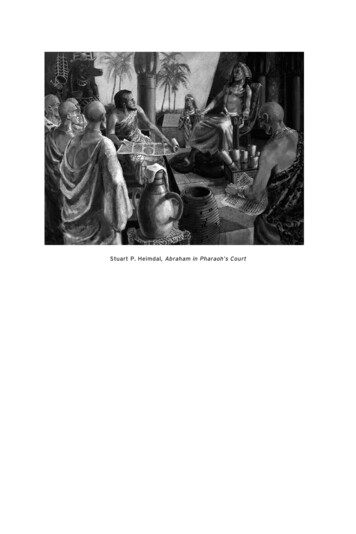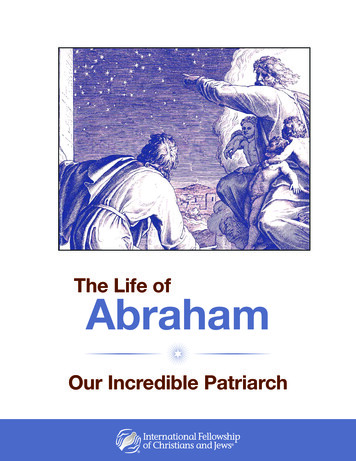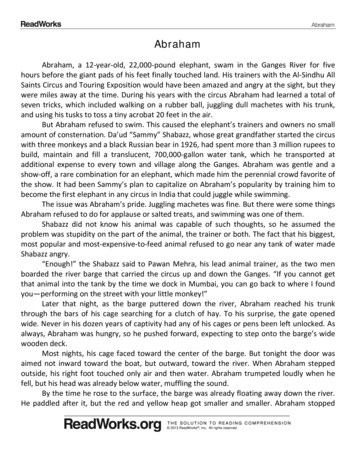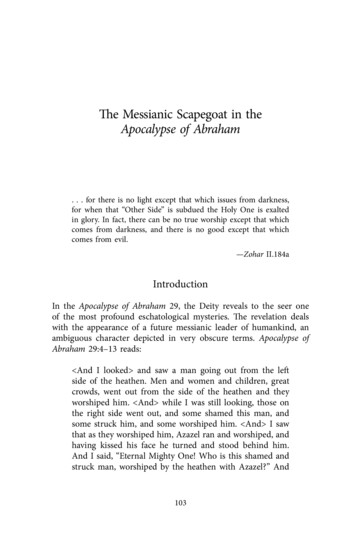
Transcription
Stuart P. Heimdal, Abraham in Pharaoh’s Court
Encircling Astronomyand the Egyptians:An Approach to Abraham 3Kerry MuhlesteinKerry Muhlestein (kerry muhlestein@byu.edu) is an assistant professor of ancientscripture at BYU.I have long held the view that the universe is built upon symbols,whereby one thing bespeaks another; the lesser testifying of the greater,lifting our thoughts from man to God, from earth to heaven, from timeto eternity. . . . God teaches with symbols; it is his favorite method ofteaching.—Orson F. Whitney1Abraham 3 is one of the most enigmatic sections of the Pearl ofGreat Price. Teacher and student together sense there is somethingmore to the text than the meaning they are drawing out of it. Eachthorough exploration gently nudges another layer of understandingfrom the text, but we always feel we have unraveled only the smallestportion of what it has to offer. Though I do not pretend to have a greatkey to unlock this revelation, I believe there are some apperceptiveprinciples that cast light on Abraham’s night vision.Certainly teachers can take a variety of approaches when teaching Abraham 3. Most students will be curious about the exotic namesprovided in verses 3 and 13, and it is worth time to address these questions.2 Investigations into the Egyptians’ astronomical abilities and howAbraham may have contributed to these abilities are also worthwhile.Undoubtedly, the Egyptians of Abraham’s day conceived of a geocentric cosmos with particular emphasis on that “which the sun encircles(šnnt ỉtn),”3 denoting the earth. In many aspects, Abraham’s visionappears to be geocentric.4 Yet Abraham also gains a “Kolob-centric”view of the universe.5 However, some aspects of Egyptian astronomical thought are not “centric” at all. It is even possible that the vision
34The Religious Educator Vol 10 No 1 2009fits no known astronomic approach because the Lord may have shownAbraham a model not yet understood by modern astronomers. However, I think we stumble when we attempt to understand Abraham’svision in terms of astronomic paradigms.6 It is quite likely that theLord was describing astronomy and the heavens allegorically in orderto teach doctrinal, not astronomical, principles. While attempting tounderstand astronomical principles has merit (though inconclusiveattempts have certainly been used against us7), and while there may bean understandable cosmic paradigm to be teased out of the narrative,it seems that the allegorical teachings are the weightier matters as far asthe gospel classroom is concerned.Abraham was no beginner in astronomy. He tells us he has therecords of the fathers and these records contain “a knowledge of thebeginning of the creation, and also of the planets, and of the stars, asthey were made known unto the fathers”; Abraham continues by making it clear that the information he records is “for the benefit of [his]posterity” (Abraham 1:31). As such, we must not only ask ourselveswhat the knowledge provided in Abraham 3 meant to those in Abraham’s time, but also what he meant for us, his latter-day posterity, toderive from it. This requires both an intensive investigation into Abraham’s era and into the ramifications of the vision for our day.It is interesting to note that Abraham appears to have two distinctvisions, one via the Urim and Thummim and recorded in the first partof chapter 3, and the second as he speaks with the Lord face to face,beginning somewhere between verses 10 and 12 (it is unclear whenAbraham goes from hearing the Lord via the Urim and Thummim totalking with Him face to face). In fact, the first part of the chapter maynot have been a vision but may have consisted of Abraham viewing thestars with his naked eye and conversing with the Lord about what hesaw by means of the Urim and Thummim.8 The second part is surely avision. In each of these visions, Abraham sees something of the cosmicsystem, which the Lord then uses apperceptively to teach doctrinalprinciples.9 In both visions, the principles taught are similar, but thefirst vision seems to discuss these principles on a more general level,and the second on a more specific level. To elucidate the lessons theLord is teaching Abraham—and teaching us through Abraham—wemust first ask some questions.Purposes of AstronomyTo understand the symbols the Lord is using in this revelation toAbraham, we must ask ourselves, why is the Lord talking to Abraham
Encircling Astronomy and the Egyptians: An Approach to Abraham 335about the stars? While the Lord often teaches His prophets about theheavens, He does not always teach the same thing in each encounter.For example, when Moses learns of God’s many creations, it is tohelp him understand the vastness of God’s great work and mankind’scentrality to that work (see Moses 1:32–39). While we do not knowwhat Joseph Smith learned about the heavens from God, it is clear helearned something that helped him understand the degrees of glory towhich mankind is headed (see D&C 76:70–71, 96–98). But why wasAbraham shown a vision of the stars and planets? What was the point?The Lord Himself partially answers this question: “Abraham, Ishow these things unto thee before ye go into Egypt, that ye maydeclare all these words” (Abraham 3:15). What words did the Lordwant Abraham to declare? If the Lord is referring to the words Heuses to describe the rotations of Kolob, the earth, the moon, andother celestial bodies, it is possible the Lord simply wanted Abrahamto teach the Egyptians astronomy. The Genesis account of Abraham’svisit to Egypt emphasizes that Abraham was enriched there (see Genesis 13:2). Perhaps the Lord used Abraham’s astronomic awareness tointroduce him to Pharaoh’s court, where he would be made wealthyand thus return to the promised land in a position of power. However,the phrase “all these words” indicates that Abraham was to teach notonly astronomy but also gospel principles the Lord explained throughastronomic means.Egyptian SymbolsIf this is the case, why did the Lord choose astronomy as the symbolic medium of His message? Why subscribe to this set of symbols?Of course, the Lord has not given us a direct answer to this question,yet there are some things we can reason out with a certain degree ofconfidence. While this is not the place for a detailed investigation intoEgyptian astronomy, some ideas are worth highlighting so we mayunderstand the magnitude of the symbolic language Abraham was toemploy in Egypt.It is indisputable that the Egyptians set significance to the movements and domains of celestial bodies. For instance, after the annualdisappearance of Sirius (Sopdet), the Egyptians knew that the rerising ofthe Dog Star generally coincided with the annual flood of the Nile. Theflood of the Nile was a type of rebirth, and thus the rebirth of the starwas a harbinger of the rebirth that Egypt experienced each year. Siriuswas also believed to serve as a guide to the deceased as they journeyedthrough the stars.10
36The Religious Educator Vol 10 No 1 2009The Egyptians designated Sirius as one of thirty-six stars knownas decans because of the heliacal role they played in a complex calendar system in which one decan replaced another every ten days. Ourknowledge of this system stems from astronomic paintings on a seriesof coffins from just before Abraham’s time. These paintings make itclear that in Abraham’s day the Egyptians placed significance on themovement of the stars.11 This is further reflected in one of the longstanding titles of the head priest of Heliopolis (biblical On), who wasknown as the chief observer.Many planets and stars played a particularly important role inEgyptian culture. Their gods were believed to have left the earth toreside in the sky;12 the moon was associated with the god Thoth, thesun with Ra, and Orion with the god Osiris. Of particular import to theking, who was associated with Horus, were the planets Jupiter, Saturn,and Mars, which were also associated with Horus. Moreover the kingwould have paid particular attention to what Abraham had to say aboutthe “greater light which is set to rule the day” (Abraham 3:6) becausethe king was integrally tied to Ra, the sun, and its journey.13Information about the stars was also important to the king. Starssuch as Gemini and Deneb were seen as significant markers in theknown course of the sun through the stars. One of the most prolificof early kingship images was the belief that the king was destined tobecome one of the circumpolar stars (the ỉhmw-sk, the stars “that didnot know destruction” because they did not disappear).14 In the afterlife the king could also become Sirius.15 Additionally, Sirius was seen ashis sister,16 which may be explained by references in which Sirius is alsoidentified with Isis17 (whereas the dead king is Osiris). Furthermore,Sirius was associated with the king’s daughter18 and the king’s father.19Orion was described both as the king20 and as the king’s brother,21 andVenus as his daughter22 and his guide.23 Amenemhet III, a likely contemporary of Abraham, wrote on the top of his pyramid that he was“higher than the heights of Orion.”24These few references amply illustrate the point: the Egyptian kingand his court were aware of and keenly interested in the movements ofthe sun, moon, planets, and stars. In our era of large cities and electriclights, it is hard to picture how much these celestial bodies were part ofEgyptian life. Most students do not regularly see starry nights becauseof light pollution. The natural nocturnal luminaries were particularlystriking in Egypt, where most nights were cloudless and very clear. Thelustrous bodies of the night sky were overlarge; they dominated thenight landscape and forced their way into the minds and visions of every
Encircling Astronomy and the Egyptians: An Approach to Abraham 337Egyptian soul. They were a much greater and pressing presence for theseancient inhabitants than most of us would naturally assume. Because ofthis powerful, intrusive sight, the stars spoke loudly to the Egyptians,whether they wanted them to or not. Their movements and power werean inescapable noise raining upon the eyes of our ancient counterparts.In my estimation, this is why Abraham would find the language ofthe stars to be a meaningful mode of communication with the Egyptians. In modern missionary parlance, astronomy enabled Abraham tobuild on common ground, and his expertise in this area helped himbuild a relationship of trust. If the Lord wanted to find ground thatwas both common and persuasive as a vehicle for teaching Pharaohand his people about the gospel, astronomy was an effective choicenot only because the Egyptians would be interested, nor solely becausethey were accustomed to celestial bodies carrying symbolic teachings,but also because the movements and principles of the stars and planetslend themselves to a powerful message.Essentially the Lord was teaching Abraham and the Egyptians bysymbolism as He so often does. As we recognize and understand thesesymbols, we not only unlock information regarding this specific revelation to Abraham, but we also become more familiar with the languageof symbolism. Working through these symbols equips our students towork through others on their own; it should help students develop bothscriptural abilities and confidence in those abilities.There is another lesson to be learned. When we see the pains towhich the Lord goes to help one of His greatest prophets be preparedto share the gospel among a strange people, we realize how importantthis is to Him. In recording this experience for his posterity, Abrahamemphasizes to us how much the Lord wants him to be prepared to keepthe charge within the Abrahamic covenant to make the Lord’s nameknown throughout the earth. Here we see Abraham going through theLord’s missionary training center; he is motivated to share the gospel,and he is equipped with both a message and tools (such as building oncommon ground) as he shares that message.Governing Points of the UniverseTo elucidate the principles taught by this astronomical message, Ihave created concentric circle models as visual aids (though we do notknow if the Egyptians employed the idea of concentric circles at thistime). Creating these models forces one to ask whether the governing body should be drawn at the center or as the outermost sphere.A good case can be made for both models. As noted, astronomy at the
38The Religious Educator Vol 10 No 1 2009time was viewed geocentrically. This would put the earth at the centerof the model with the greater bodies in the outer orbits. This modelwould have been particularly meaningful to the Egyptians. With ourmodern astronomical viewpoint, we tend to think of the center as thepoint of control or governance. The sun is the center of our solar system, governing the system by its gravitational pull. The sun is revolvingaround a central gravitational point in our galaxy (likely a black hole),and even the galaxies are revolving around a central gravitationalpull in our supercluster of galaxies.25 And yet, in the Lord’s analogygiven to the Egyptians through Abraham, if the earth is at the center,then it is not the central point that governs, but the outermost pointthat encircles all else. This is aligned with Egyptian thinking in manyrespects, though it seems contrary to a geocentric point of view. Forthe Egyptians, encircling something was a powerful symbol of controlling or ruling over it, often including an element of protecting whatwas encircled. Power over creation was shown by Ra, who encircledthe earth. The deceased wished to have such power by “going about(dbn) the two heavens, encircling (phr) the two lands.”26 The deceasedking is pictured as more powerful than even the gods by describinghim as one who has “encircled (šn.n k) every god in your arms, theirlands and all their possessions. O King, you are great, you are wrappedaround (dbn) like the circle which encircles (ph r) the great rulers.”27In Egyptian thought, it is that which encircles that controls, not thatwhich is in the center. Thus in a geocentric model, the vision givenAbraham places God at the outer orbits.On the other hand, there is some evidence that we would do bestto draw Kolob, or the governing point, at the center of our model.Michael Rhodes has suggested an etymology for Kolob as coming fromthe “Semitic root QLB, which has the basic meaning of ‘heart, center,middle.’”28 This is corroborated by Joseph Smith’s explanation of thecenter figure of the hypocephalus in facsimile 2 as Kolob. These ideasindicate a model with Kolob at the center. The central point of anymodel is completely a matter of perspective. The earth orbits the sun,but from our perspective it appears that the sun circles the earth.Because Pharaoh already conceived of the sun circling the earthand other significant bodies moving in cyclical journeys around theearth and sun, he would have easily understood the concept that heavenly orbs revolved around each other in concentric circles. Thus theinformation given to Abraham in verses 3 through 7 would have madeperfect sense. For each known orb there was another above it until the
Encircling Astronomy and the Egyptians: An Approach to Abraham 339governing body was reached. Pharaoh could easily picture a cosmoswhich looked thus:Fig. 1. Pharaoh’s concept of cosmosIn the end, we cannot know which way Abraham or the Egyptianswould have drawn their models, with the governing point at the centeror as the body which encircles all else. I have chosen to make my illustrations with the governing point at the center because it is the mostintuitive model. For us, saying that God is at the center means He is thefocal, governing point, and pedagogically this is preferable. Thus, forour purposes, the cosmos Abraham was explaining could look like this:Fig. 2. Abraham’s concept of cosmos
40The Religious Educator Vol 10 No 1 2009This picture of the cosmos helps us visualize what Abraham wasteaching Pharaoh. The crucial information came in verses 8 and 9:“And where these two facts exist, there shall be another fact abovethem, that is, there shall be another planet whose reckoning of timeshall be longer still; and thus there shall be the reckoning of the timeof one planet above another, until thou come nigh unto Kolob, whichKolob is after the reckoning of the Lord’s time; which Kolob is set nighunto the throne of God, to govern all those planets which belong tothe same order as that upon which thou standest.” Here the conceptof orbiting planets and their governing times was used as apperceptionto explain that a being—not a planet—was the governing source. Thiswould give the glorious Egyptian king something to think about.He would have clearly understood that there were many rulersupon the earth and that they possessed differing magnitudes of power.For example, the Egyptians knew of a Canaanite ruler in Jerusalem butconsidered him subservient to Egypt, and thus he would have beenconsidered to be on one of the lesser orbits of rulers. Pharaoh probably also knew of Mesopotamian kings, perhaps King Ur-Nammu ofthe city of Ur. This leader would likely have been viewed as occupyingan orbit closer to the Egyptian ruler. The Nubian kingdom of Kushhad become powerful by this time, but again the Egyptians dominatedthis group. The probability is great that the Egyptian king consideredhimself to be the body that governed the orbits of leadership, the greatcentrifugal power controlling earthly leaders.Fig. 3. Pharaoh-centered universe
encircling astronomy and the egyptians: an approach to abraham 341What would have been startling, yet logical, was the reasoning thatif there were two facts, one was higher than another and there mustbe yet another higher still (see v. 8). Thus, if Pharaoh was above theking of Kush, it stood to reason that someone was above Pharaoh.Abraham’s assertion would have been that this series of successionscontinued, not merely until Pharaoh was reached but until God wasreached. The paradigm presented to Pharaoh was that he was not themost high ruler after all.Fig. 4. Universe governed by higher powersThe teaching of astronomy would have gotten the king’s attention.The principles of government apperceptively taught would have madesense. This allowed Abraham to teach that mankind must fear God,not man (even a man considered semidivine). But the lesson did notnecessarily stop there. These concentric circles of governance and ordercould also be used to teach of the organization of the kingdom of Godon earth, which in Abraham’s day operated under the patriarchal order.Thus Abraham, Pharoah, we, and our students understand that wefollow the orbits of governance from ourselves to our parents, grandparents, and so forth, until the person who reports to God is reached,and thus we again find God as the focal, governing point.
42The Religious Educator Vol 10 No 1 2009Fig. 5. Patriarchal orderIncidentally, this can be used to teach about current Churchgovernment as well, demonstrating that the symbolism in Abraham 3speaks not only to Abraham’s generation but to ours as well.Fig. 6. Church governmentThis God-centered view of the universe teaches Abraham, theEgyptians, and us another powerful message. Even within a gospelcontext it is easy to focus on various principles without tying them into the great center, God. For example, it is easy to teach modesty, honesty, the Word of Wisdom, or the law of tithing without connectingthem to the center of the gospel: God, His Son, and the Atonement.
Encircling Astronomy and the Egyptians: An Approach to Abraham 343Even such edifying principles as these can be distracting if they are disassociated from that central focus. President Boyd K. Packer describedthe Atonement as being “the very root of Christian doctrine. You mayknow much about the gospel as it branches out from there, but if youonly know the branches and those branches do not touch that root, ifthey have been cut free from that truth, there will be no life nor substance nor redemption in them.”29 As Thomas B. Griffith said in a BYUdevotional, “If you cannot figure out the link between the topic youare to teach and the Atonement of Christ, you have either not thoughtabout it enough or you shouldn’t be talking about it at church.”30When properly understood, the God-centered vision that Abraham 3presents us should help us to remember that every aspect of the gospelis governed by its great center: God, His Son, and the Atonement.The analogies Abraham is able to draw from the heavens increasebecause God seems to immediately show him an expanded vision of Hiscreations: “And he said unto me: My son, my son (and his hand wasstretched out), behold I will show you all these. And he put his handupon mine eyes, and I saw those things which his hands had made,which were many; and they multiplied before mine eyes, and I couldnot see the end thereof ” (Abraham 3:12). Not only did Abraham seemore in the vision, but God also taught him more.God’s Relationship with Abraham and with UsFor example, God expounded on the blessings of the Abrahamiccovenant. It is difficult to know how much of the covenant had beenestablished with Abraham at this point. In Genesis 12, just beforegoing to Egypt, Abraham is told that the Lord will make of him a greatnation and that the Lord will bless those that bless Abraham and cursethose that curse Abraham (see Genesis 12:2–3). These are two of themost important aspects of the Abrahamic covenant.31 It is tempting toconsider the vision that is recorded as Abraham 3 as an extended recordof when the Lord brought Abraham “forth abroad, and said, Looknow toward heaven, and tell the stars, if thou be able to number them:and he said unto him, So shall thy seed be” (Genesis 15:5), except thatin the Genesis account this takes place after the trip to Egypt. Perhapsthere is a problem with the chronology of the Genesis account. Duringthis same incident, Abraham makes sacrifices, divides the portions intohalves, and walks before them in what is almost certainly symbolic of“cutting a covenant”—a literal translation of the Hebrew phrase—withGod. As the sacrifice is accepted, the Lord covenants that Abrahamwill have a land of promise (see Genesis 15:9–21), another important
44The Religious Educator Vol 10 No 1 2009aspect of the covenant. Yet only later is Abraham told, “I will makemy covenant between me and thee,” and then has other aspects of thecovenant confirmed and his name changed (Genesis 17:2–8).It is difficult to tell if the covenant was established in stages—as itseems to be with us, who enter the covenant at baptism but more fullypartake of it in the marriage covenant—or if it was given wholly at onceand then reconfirmed in various ways at various times or if there is aproblem with the Genesis text as we have received it.32 Thus, we cannotbe certain at what stage of the covenant Abraham was when he receivedthe vision recorded in Abraham 3, but he at least knew something ofit. He also had the covenant’s aspect of progeny reconfirmed when,in the midst of supernaturally33 seeing the stars, God told him, “I willmultiply thee, and thy seed after thee, like unto these; and if thou canstcount the number of sands, so shall be the number of thy seeds” (Abraham 3:14). It is interesting that in the midst of seeing a vision designedto instruct him as to what he should teach the Egyptians, Abraham isreminded of how the heavens tie into God’s covenant with him.The apperception analogies that God employs in this fuller visiontake a step beyond those He had employed in the first. In those explanations God had focused on nondescript entities with God at the center,allowing for organizational and institutional comparisons. In the secondvision God applies the same principles to the individual. After showingAbraham the vastness of His creations, He again speaks of the orbiting bodies, that Kolob is the greatest of the stars—significantly, againbecause it is nearest to Him—and that the moon, the earth, and all thestars coexist with celestial bodies both above and below them in theorder of orbits (see Abraham 3:16–17). Yet immediately this is followedby a comparison to spirits, or intelligences, which God makes clear havealways existed and always will exist (see Abraham 3:18). Each individualbeing, like the stars, will find that there is a being less intelligent thanthey and a being more intelligent than they. The exception is God:“There are two spirits, one being more intelligent than the other; thereshall be another more intelligent than they; I am the Lord thy God, Iam more intelligent than they all” (Abraham 3:19). This point is similarto that made after Abraham’s first vision, except that it focuses more onthe universality and simultaneous individuality of the application.Almost as if to demonstrate this clearly, after this declaration theLord makes an immediate transition. The very next thing He says is,“The Lord thy God sent his angel to deliver thee from the hands ofthe priest of Elkenah” (Abraham 3:20). How curious this insertion is!On the face of it there is no connection between this statement and the
Encircling Astronomy and the Egyptians: An Approach to Abraham 345grand principles God had just been elaborating. Yet it proves exactlythe point of the individuality God is emphasizing. God has just madeHis greatness clear. Not only is He the Creator of the vast expanse andnumberless bodies Abraham has just seen—and not seen, for he “couldnot see the end thereof” (Abraham 3:12)—but He is all-powerful, for“there is nothing that the Lord thy God shall take in his heart to dobut what he will do it” (Abraham 3:17). Finally He emphasized thatHe is greater than everything else.I would imagine that seeing the Lord face to face and beholdingthese vast creations (seemingly more than Moses initially saw in Moses1) must have been overwhelming and humbling, and I suppose Godintended that effect to some degree. Yet God did not leave Abrahamat that point. Immediately after helping Abraham realize how smallhe is, and how immense God is, God also reminds Abraham of theirrelationship with each other; after all, it was this glorious God who hadcared so much about Abraham that He had reached out and saved him.The reminder of the covenant in verse 14 must have done somethingsimilar. Abraham is in the midst of seeing the greatness of God’s creations, and God reminds him that He intends to make Abraham justas great a creator in the realm of progeny. Abraham here encountersa God that overwhelms him with His magnitude and then remindshim how personal their relationship is and how much God cares forAbraham, demonstrated both in what He has done and what He willdo. We must understand that as it was with Abraham, so it is with us.We are dealing with a magnificent yet magnanimous and personal Godwho will help deliver us from our own difficulties.Abraham has learned much about God and his relationship withGod, but he has also learned about the relationship of every individualwith God.However, there is more. In the model of orbiting spheres, eachbeing is affected by those above it, and in turn affects those below it.While we are ultimately dependent upon God, we are also indubitablyintertwined with each other in our approach to God. We cannot comeunto God irrespective of our relationships with others. As the Lordsaid, “Therefore if thou bring thy gift to the altar, and there rememberest that thy brother hath ought against thee; leave there thy gift beforethe altar, and go thy way; first be reconciled to thy brother, and thencome and offer thy gift” (Matthew 5:23–24).
46The Religious Educator Vol 10 No 1 2009Intelligence in God’s EyesAs we look at God’s description of our interrelationships and theclear declaration that some beings are more intelligent than others,students often feel some discomfort. The wording and appreceptivecomparison establishes something akin to the Great Chain of Being.34Clearly a hierarchy is a part of this description of the universe. Thenatural question that arises from our egalitarian-oriented societies is,why are some beings more intelligent than others? This question lendsitself to a discussion of what seems to be God’s next topic in His revelation to Abraham. As we entertain this concept, we must be cognizantof two scriptural definitions of intelligence: (1) the uncreated identityof each individual and (2) “light and truth.” I am not convinced thatthe two definitions are completely separate and unrelated. We mustalso keep in mind that the principles we are about to discuss concerningintelligences are connected to the astronomical principles we have justreviewed. Both are designed to help us understand our nature and ourposition in relation to God. It is God who makes the transition withinthe revelation, and as we follow His reasoning, we will come to furtherunderstand what he is trying to teach Abraham and us—Abraham’sposterity—about our intelligences and our standing with God.Section 93 of the Doctrine and Covenants is most illustrative inour attempts to answer the question of why some beings are moreintelligent than others. It first helps us define intelligence. We are told,“Intelligence, or the light of truth, was not created or made, neitherindeed can be” (D&C 93:29), and, “The glory of God is intelligence,or, in other words, light and truth” (D&C 93:36). This indicates thatthe degree of intelligence depends upon the amount of light and truthwe have received.The section also illustrates how to receive light and truth. Itdescribes this process for the Savior, saying, “He received not of thefulness at the first, but received grace for grace; and he received not ofthe fulness at first, but continued from grace to grace, until he receiveda fulness” (D&C 93:12–13). The example set by Christ is then appliedto us: “And no man receiveth a fulness unless he keepeth his
Undoubtedly, the Egyptians of Abraham's day conceived of a geocen-tric cosmos with particular emphasis on that "which the sun encircles (šnnt ỉtn),"3 denoting the earth. In many aspects, Abraham's vision appears to be geocentric.4 Yet Abraham also gains a "Kolob-centric" view of the universe.5 However, some aspects of Egyptian .










